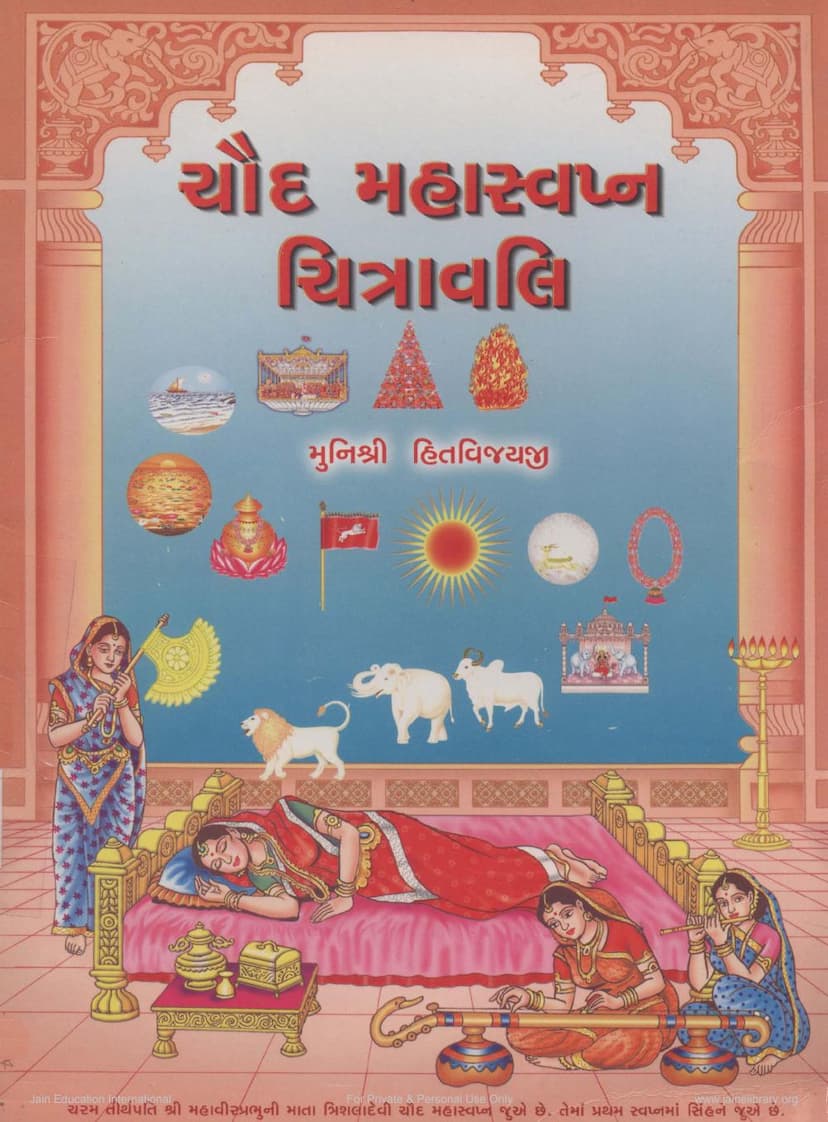Chaud Mahaswapna Chitravali
Added to library: September 1, 2025

Summary
Here is a comprehensive summary of the Jain text "Chaud Mahaswapna Chitravali" (Twelve Great Dream Illustrations) by Munishri Hitvijay, published by Sanghavi Ambalal Ratanchand Jain Dharmik Trust:
Book Title: Chaud Mahaswapna Chitravali (ચૌદ મહાસ્વપ્ન ચિત્રાવલિ) Author: Munishri Hitvijay (મુનિશ્રી હિતવિજયજી) Publisher: Sanghavi Ambalal Ratanchand Jain Dharmik Trust (સંઘવી અંબાલાલ રતનચંદ જૈન ધાર્મિક ટ્રસ્ટ)
Overall Purpose and Content:
This book meticulously details the "Fourteen Great Dreams" (Chaud Mahaswapna) as described in Jain scriptures, which are traditionally seen by the mothers of Tirthankaras (Enlightened Beings) before their birth. The book aims to provide a visual and descriptive representation of these profound dreams, linking them to their auspicious meanings and symbolic interpretations. It seeks to deepen the reader's understanding and devotion towards the Tirthankaras and their mothers.
Key Themes and Structure:
The book is structured around presenting each of the fourteen dreams, accompanied by detailed scriptural descriptions and artistic illustrations. For each dream, it provides:
- The Dream Itself: A vivid textual description of the dream as it is traditionally understood.
- Illustrations: Beautifully rendered drawings of each dream, striving to adhere closely to the scriptural descriptions.
- Special Notes (Vishesh Nondh): These notes offer crucial clarifications and important details about the dreams, often highlighting subtle but significant scriptural points that might be missed or misinterpreted.
- Dream Interpretation (Swapna Phal): The auspicious meaning and prophecy associated with each dream, typically relating to the qualities and significance of the Tirthankara who will be born.
- Related Concepts: The book often includes supplementary information such as:
- Animal/Object Behavior (Vrutti/Gajvruti etc.): Explanations of the symbolic behavior or characteristics of the animals or objects in the dreams.
- Qualities of a Tirthankara: Descriptions of the specific virtues and characteristics that the dream portends for the Tirthankara.
- Ethical Teachings: Moral lessons and guidance derived from the scriptures and the context of the dreams.
- Jain Practices: References to Jain rituals, customs, and the importance of adhering to the teachings.
The Fourteen Dreams and Their Significance:
The book systematically describes and illustrates the following fourteen dreams:
- Elephant (Haathi): Often depicted as four-tusked, white, and majestic, symbolizing the Tirthankara's virtue and teaching of the four-fold Dharma (Dan, Sheel, Tap, Bhav).
- Bull (Vrushabh): White and radiant, signifying the Tirthankara as a planter of seeds of enlightenment in the land.
- Lion (Sinh): White and beautiful, representing the Tirthankara as a protector of virtuous souls against evil forces.
- Goddess Lakshmi (Shri Devi): Seated on a lotus surrounded by celestial beings and lotuses, symbolizing the Tirthankara's attainment of spiritual wealth and universal prosperity.
- Garland of Flowers (Phoolmala): A fragrant and beautiful garland, symbolizing the Tirthankara's eminence and the reverence due to him from all beings.
- Full Moon (Purnimano Chand): Bright and serene, signifying the Tirthankara who will bring joy and illumination to the entire world.
- Sun (Surya): Radiant and powerful, symbolizing the Tirthankara who will be adorned with a divine halo of light.
- Flag (Dhvaj): A golden banner with a majestic lion emblem, representing the Tirthankara as one who upholds the flag of Dharma.
- Full Pot (Purnakalash): A pot brimming with auspiciousness and surrounded by lotuses, symbolizing the Tirthankara as the pinnacle of the grand palace of Dharma.
- Lotus Pond (Padmasarovar): A vast pond filled with various lotuses, signifying the Tirthankara who will walk on lotuses offered by celestial beings.
- Ocean of Milk (Khirsamudra): A churning ocean, symbolizing the Tirthankara as the abode of the jewels of Keval Gyana (Omniscience).
- Celestial Chariot/Vehicle (Devaviman): A radiant and magnificent flying vehicle, signifying the Tirthankara as revered even by celestial beings.
- Heap of Jewels (Ratnarashi): A large pile of precious gems, symbolizing the Tirthankara adorned with the fortresses of jewels (referring to the Samavasarana, the divine preaching assembly).
- Smokeless Fire (Nidhūmagni): Pure and bright fire, signifying the Tirthankara who purifies the gold of virtuous souls.
Author and Contributors:
- The book is authored and compiled by Munishri Hitvijayji, a disciple of the revered Acharyadev Shrimad Vijay Ravichandrasurishwarji Maharaj.
- The illustrations are credited to Shri G.J. Sandhwani, who is described as a humble, simple, and creative artist with a natural talent for drawing. The author emphasizes the artist's dedication and the detailed guidance provided to him to ensure the illustrations accurately reflect the scriptural descriptions.
Publisher and Edition:
- Published by Sanghavi Ambalal Ratanchand Jain Dharmik Trust.
- The text mentions a Second Edition (Dvitiya Avruti) published in Vir Samvat 2529 / Vikram Samvat 2059 / 2003 CE, indicating revisions and improvements over the first edition.
Key Messages and Teachings:
- The Power of Visuals: The book highlights the immense impact of visual representation, stating that pictures are a thousand times more effective than words. It aims to make the abstract concepts of the great dreams tangible.
- Importance of Scriptural Accuracy: A strong emphasis is placed on adhering to the scriptural descriptions when depicting the dreams, recommending that future artistic representations (like silver models in temples) follow these guidelines.
- Devotion and Understanding: The ultimate goal is to foster devotion and a deeper understanding of the significance of the Tirthankaras, their birth, and the auspicious signs associated with them.
- Ethical Conduct: Interspersed throughout the book are various ethical teachings and reminders about Jain principles, such as the importance of respecting elders, avoiding harm to living beings, and proper conduct.
- The Nature of Dreams: The book also delves into the science of dreams (Swapna Shastra), discussing different types of dreams, their potential outcomes, and how to interpret them, as well as the specific qualities of individuals who receive prophetic dreams.
In essence, "Chaud Mahaswapna Chitravali" is a scholarly and artistic endeavor to bring to life the profound spiritual significance of the Fourteen Great Dreams in Jainism, serving as a guide for devotees and scholars alike to appreciate these sacred visions and their prophetic implications.